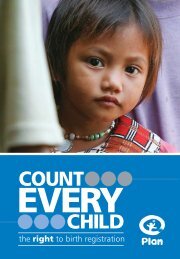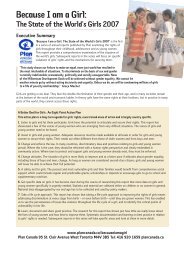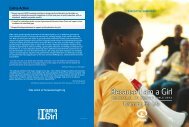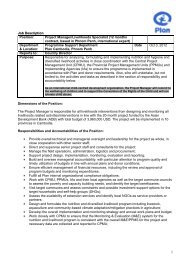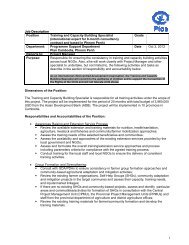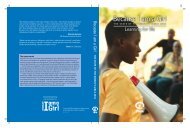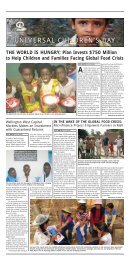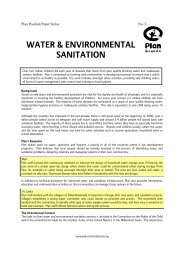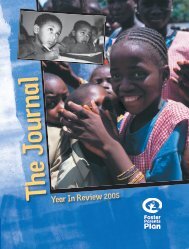Plan Worldwide Annual Review and Combined Financial ...
Plan Worldwide Annual Review and Combined Financial ...
Plan Worldwide Annual Review and Combined Financial ...
Create successful ePaper yourself
Turn your PDF publications into a flip-book with our unique Google optimized e-Paper software.
c. Basis of combined financial statements<br />
The financial statements of <strong>Plan</strong> are a combination of the consolidated accounts of the 20 National Organisations (NOs) <strong>and</strong> the consolidated<br />
accounts of <strong>Plan</strong> International, Inc. (PI Inc). The businesses included in the combined financial statements have not operated as a single entity.<br />
There is no legal requirement to prepare these combined financial statements as PI Inc <strong>and</strong> the NOs are separate legal entities. However, the<br />
combined financial statements are prepared voluntarily in order to present the combined financial position, results <strong>and</strong> cash flows of <strong>Plan</strong>.<br />
New entities have their consolidated assets <strong>and</strong> liabilities combined into <strong>Plan</strong> from the date they become a Member NO or from the date that<br />
they start the process of qualifying as Members, unless they are already part of <strong>Plan</strong>. As entities are combined into these financial statements by<br />
becoming Members, there is typically no consideration paid by <strong>Plan</strong>. Hence, in bringing their consolidated assets <strong>and</strong> liabilities into the combined<br />
financial statements, this results in an amount also recognised in fund balances. This accounting policy is applied consistently to all such transactions.<br />
Pl Inc is controlled by its Members, but no one Member NO has the direct or indirect ability to exercise sole control through ownership,<br />
contract or otherwise. The NOs are independent entities which control their own subsidiaries. As set out in the Directors’ report, each NO<br />
has objectives, purposes <strong>and</strong> constitutions compatible with those of PI Inc. PI Inc has a wholly owned central services subsidiary in the United<br />
Kingdom (<strong>Plan</strong> Limited). In programme countries, PI Inc operates through branches, except in Brazil where it has established a separately<br />
incorporated association (<strong>Plan</strong> International Brasil). During 2012 <strong>Plan</strong> Italia Onlus commenced operations as a subsidiary of PI Inc <strong>and</strong> is on<br />
the pathway to becoming a Member <strong>and</strong> NO of PI Inc. All transactions <strong>and</strong> balances between entities included in the combined financial<br />
statements are eliminated.<br />
d. Accounting for income<br />
i) Most income raised by <strong>Plan</strong> comprises child sponsorship contributions. In general, these contributions are paid on either a monthly or<br />
annual basis. They are accounted for as income when received, including any contributions received in advance. Amounts received in<br />
advance are presented within temporarily restricted funds on the combined statement of financial position.<br />
ii) Certain contributions receivable by <strong>Plan</strong>, including the majority of the grants from Government bodies <strong>and</strong> other NGOs, are designated for<br />
specific purposes by the donors. These contributions are recognised when the relevant donor-stipulated requirements for receipt have been<br />
met <strong>and</strong> <strong>Plan</strong> is entitled to receive the income. Any such contributions which have been recognised in income but remain unspent at the<br />
year-end are presented within temporarily restricted funds on the combined statement of financial position.<br />
iii) <strong>Plan</strong> receives contributions from various other sources, including legacies <strong>and</strong> trusts in which it is named as a beneficiary (but over which it<br />
has neither control nor significant influence). These contributions are recognised when <strong>Plan</strong> has an irrevocable entitlement to receive future<br />
economic benefits <strong>and</strong> the amounts are capable of reliable measurement.<br />
iv) Gifts in kind are recognised at fair value when received using the cost of the equivalent goods or services in the country of the ultimate<br />
beneficiary, which appropriately reflects the underlying value of <strong>Plan</strong>’s work to the beneficiaries.<br />
v) Investment income represents both PI Inc’s <strong>and</strong> the National Organisations’ interest <strong>and</strong> dividend income, all of which is recognised<br />
when <strong>Plan</strong> becomes entitled to the income, <strong>and</strong> realised gains <strong>and</strong> losses on the sale of investments. Interest income on debt securities is<br />
measured using the effective interest method.<br />
vi) <strong>Plan</strong> benefits from the assistance provided by a large number of volunteers both in NOs <strong>and</strong> PI Inc. It is not practicable to quantify the<br />
benefit attributable to this work, which is therefore excluded from the combined income statement.<br />
e. Accounting for expenditure<br />
Expenditure is recognised in accordance with the accruals concept. Programme expenditure which does not involve the receipt of goods or<br />
services by <strong>Plan</strong>, including payments to the communities <strong>and</strong> other NGOs with which <strong>Plan</strong> works, is recognised either when the cash is paid<br />
across to a third party or, if earlier, when an irrevocable commitment is made to pay out funds to a third party.<br />
16




